Are you looking for a pet that will really impress your friends and family? Then look no further than the jumping spider!
Not only are they one of the cutest spiders around, but, they are also some of the easiest pets to take care of “especially” for beginners!
However, if your wondering just how large these spiders can get, here is a list of the 7 largest jumping spiders in the world!
Size Comparison Table
To provide an easier comparison of their sizes and other characteristics, we have organized the information into a table below.
| Species | Average Size | Color | Habitat |
|---|---|---|---|
| Giant Jumping Spider | 1.8 – 2.5cm | Brown body, with white lines | Openfields, woodlands |
| Heavy Jumping Spider | 7.8 – 8.9mm | Yellow body, black strips | Tree trunks, under leaves |
| Zebra Jumping Spider | 4.0 – 6.4mm | White with black markings | Tree trunks, under rocks |
| Bold jumper Spider | 6.0 – 13mm | Iridescent green chelicerae | Milkweed plants, fence posts |
| Emerald Jumping Spider | 7.0 – 10mm | Vibrant emerald green coloration | Woodlands with humid climate |
| Gray Wall Jumper | 8.0 – 9.0mm | Grayish hairs, brown bristles | Coastal areas, rocky surfaces |
| Fringed Jumping Spider | 5.2 – 10mm | Legs are adorned with fringes | Trees, rocks, and walls |
The table above provides a quick overview of the seven largest jumping spiders! But, if you want more information about these species, and to see what they look like, keep reading!
Related Post:
7 Largest Jumping Spiders In The World
1. Giant Jumping Spider – Hyllus Giganteus
The Hyllus Giganteus, also known as the Giant Jumping Spider, is a species of spider that is native from Sumatra to Australia.
The Giant Jumping Spider is the largest known species of all jumping spiders. Females are slightly bigger, with a body length of up to 2.5 cm, and the males 1.8cm.
They have distinctive brown strips on their faces with a black band on their heads. They also have two white lines, down the sides of their body.
Their eyesight is exceptional, with four pairs of eyes and the ability to see in all directions.
These spiders can be found in a variety of habitats, including forests, grasslands, and even in urban areas.
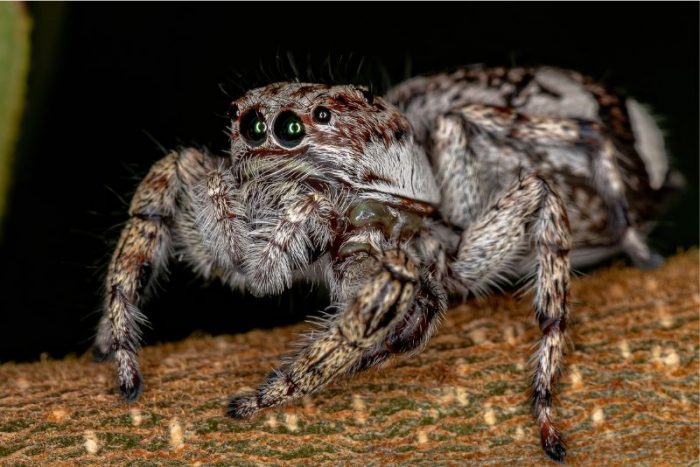
They are also known for their hunting tactics, which involve stalking and pouncing on their prey. They primarily feed on insects, like roaches, amd crickets.
During mating, the male spider performs a courtship dance to attract the female. Once the female accepts the male, they will mate, quickly, afterwards, the female will lay her eggs.
Adult Size
- Adult Female Size: 2.5cm
- Adult Male Size: 1.8cm
Lifespan
- In The Wild: 6 months – 2 Years
- In Captivity: Up To 3 Years
2. Heavy Jumping Spider – Hyllus Semicupreus
The Hyllus semicupreus, commonly known as semi-coppered heavy jumper, is a species of jumping spider of the genus Hyllus, and is native to India, Sri Lanka, and Pakistan.
When it comes to the size of the heavy jumping spider, the females are usually larger at 8.9mm. The males are slightly smaller at 7.8mm.
They typically have a yellow body with black strips on their abdomen, and black tips on their legs.
These spiders are commonly found in the trunks of coconut tree and make thick silken webs under the leaves.
Their diet consists of small insects like grasshoppers, flies, moths, and even other spiders.
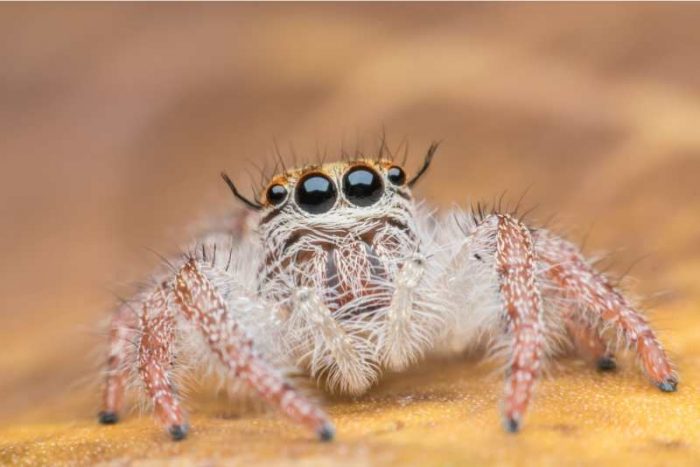
They use their powerful legs to pounce on their prey, which they use as an ambush method They are also known for their excellent eyesight, which allows them to see in nearly all directions.
Adult Size
- Adult Female Size 8.9mm
- Adult Male Size 7.8mm
Lifespan
- In The Wild: 6 – 10 Months
- In Captivity: Up To 1 Year
3. Zebra Jumping Spider – Salticus Scenicus
The Zebra Jumping Spider, also known as the Salticus Scenicus, is a small but, a striking predator found in many parts of the world.
Their size can range from 4.3 – 6.4 mm in length, for females and 4 – 5.5 mm for males. Again, with most of these spiders, the females are usually bigger than the males.
One distinguishing feature of the Zebra Jumping Spider is its bold, black and white striped body.
These spiders found in a variety of habitats, including gardens, meadows, and often in plants.
They are most commonly found in open areas where they can hunt and move around freely.
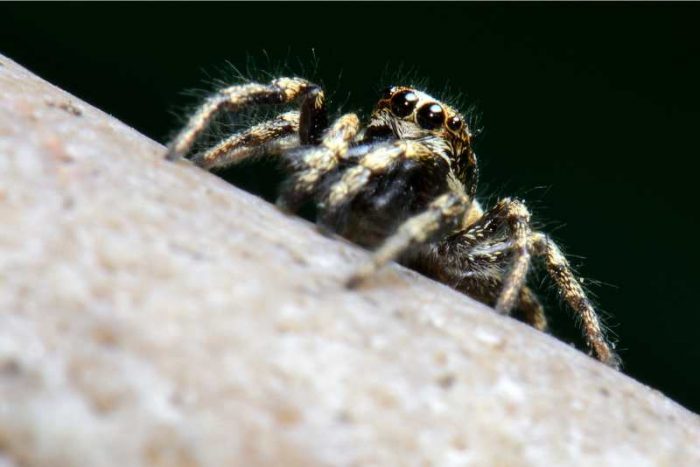
Like all spiders, Zebra Jumping Spiders are carnivorous and eat live insects, including crickets, fruit flies, and flies. However, when feeding this spider make sure the food you provide is the appropriate size.
Adult Size
- Adult Female Size: 4.3 – 6.4 mm
- Adult Male Size 4.0 – 5.5 mm
Lifespan
- In The Wild: 1 – 2 Years
- In Captivity: Up To 3 Years
4. Bold Jumping Spider – Phidippus Audax
The Bold Jumping Spider, also known as Phidippus Audax, is a very common species of jumping spider found in North America. They are known for their bold and curious nature, making them a favorite of new owners.
Bold Jumping Spiders are relatively small, but ,is still one of the largest of its speices, with males measuring between 6 – 13 mm in length, and females growing between 8 – 19mm.
They have a distinctive hairy body with black and white patterns, with iridescent green or blue chelicerae, or jaws.
Their legs are covered in fine hairs, which they use for gripping and climbing.
These spiders can be found in a variety of habitats, including fields, forests, and gardens.
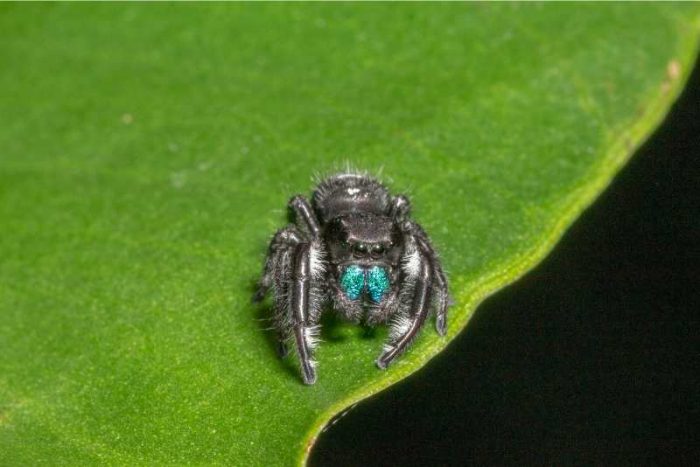
They are most commonly found near human dwellings, often near windows or under eaves. Bold Jumping Spiders are also known for their curious and playful nature.
They will often approach humans and other animals without fear, and even seem to enjoy being observed. Making them great as pets!
Related Post: Do Jumping Spiders Drink Water?
Adult Size
- Adult Female Size: 8.0 – 19 mm
- Adult Male Size: 6.0 – 13 mm
Lifespan
- In The Wild: 6 Months – 2 Years
- In Captivity: Up To 3 Years
5. Emerald Jumping Spider – Paraphidippus Aurantius
The Emerald Jumping Spider, also known as Paraphidippus Aurantius, is a species of jumping spider that can be found anywhere from Delaware to Nebraska, and Florida or Arizona.
Emerald Jumping Spiders are usually about 8-12mm in length, with males being somewhat smaller, typically 7-10mm.
They are easily identifiable, thanks to their vibrant emerald green, and blue with white and black stripes.
Their eyes are black and beady, giving them an almost quizzical expression.
These spiders can be found in a variety of habitats from woodlands to cities, but they tend to prefer humid climates.
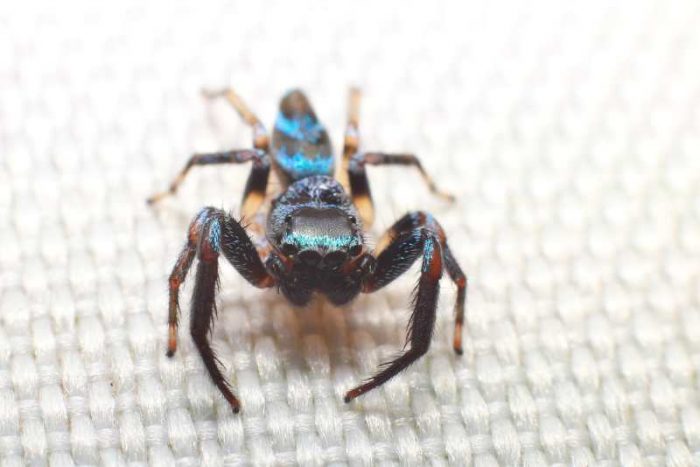
Emerald Jumping Spiders are active hunters during the day and will patrol their territory looking for prey. Like other jumping spiders, they use their powerful legs to leap onto unsuspecting prey or escape threats.
The average lifespan of an Emerald Jumping Spider is about 1-2 years, but some individuals can live up to 3 years in captivity.
In the wild, they may have shorter lifespans due to predators and environmental conditions such as snow and cold temperatures
Adult Size
- Adult Female Size: 8.0 – 12 mm
- Adult Male Size: 7.0 – 10 mm
Lifespan
- In The Wild: 6 Months – 2 Years
- In Captivity: Up To: 2 – 3 Years
6. Gray Wall Jumper – Menemerus Bivittatus
The Gray Wall Jumper, also known as Menemerus bivittatus, is a species of jumping spider native to Europe and parts of Asia. They are named for their tendency to rapidly climb walls or other vertical surfaces.
The Gray Wall Jumper, is usually 8-9 mm in length with the males being slightly smaller than their counterparts.
These spiders have a distinctive silvery-gray coloration with two dark stripes running down the length of their body.
They also bear two large eyes on the front side that are usually brightly colored and surrounded by black markings.
Gray Wall Jumpers tend to inhabit coastal areas where there are lots of rocky surfaces for them to cling onto and hunt from.
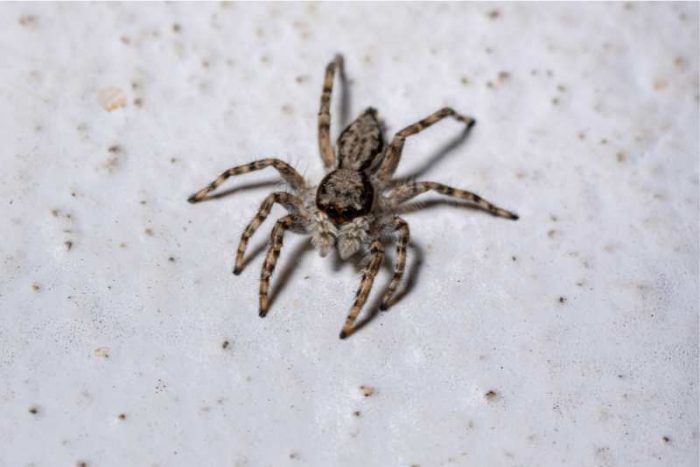
They can often be found near buildings, bridges, and walls since these provide plenty of vertical surfaces for them to climb.
Adult Size
- Adult Female Size: 9.0 mm
- Adult Male Size: 8.0 mm
Lifespan
- In The Wild: 6 months – 1 Years
- In Captivity: Up To 1 – 2 Years
7. Fringed Jumping Spider – Portia Fimbriata
The Fringed Jumping Spider, or Portia fimbriata, is a species of jumping spider that is native to the northen parts of Australia, including Western Australia, Northern Territory, and Queensland.
These spiders are usually 6.8 to 10.5 millimeters long, with the males being smaller at 5.2 to 6.5 millimeters.
They have been observed by scientists to possess a high level of intelligence and adaptability, making them one of the most interesting spiders in the world.
In some places, like Australia, they thrive in dry areas due to their water-retaining abilities which allow them to survive long periods without drinking any water.
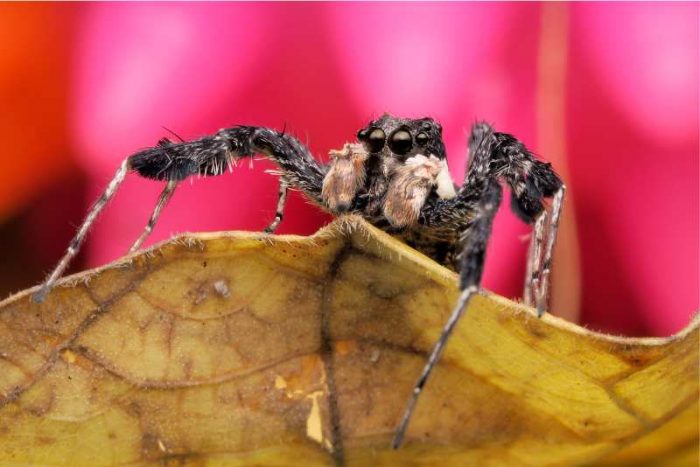
Their body and legs are adorned with fringes getting the name “the fringed spider” with tufts of brown, white and black hairs. This spider definitely has a unique look and can often be mistaken for old leaves.
Adult Size
- Adult Female Size: 6.8 – 10.05 mm
- Adult Male Size: 5.2 – 6.5 mm
Lifespan
- In The Wild: 1 year
- In Captivity: Up To 1.5 years
Conclusion
So there are the 7 largest jumping spiders in the world! All of the species mentioned in this article do make great pets, tho some maybe harder to find, depending on where you live.
Related Posts:



